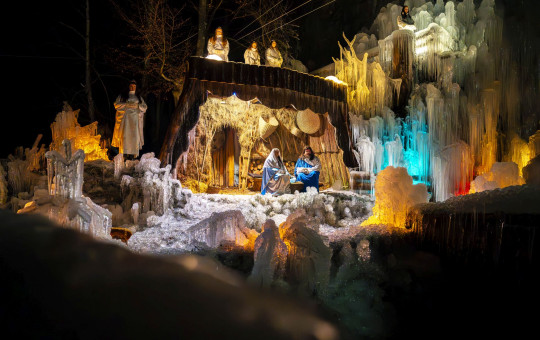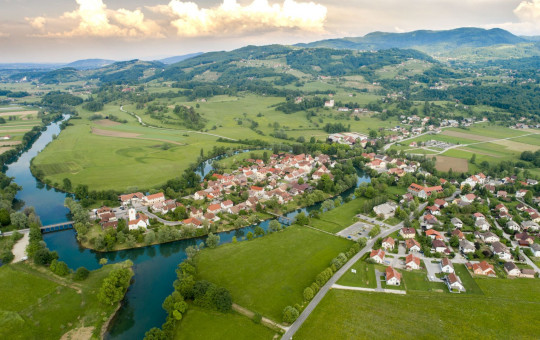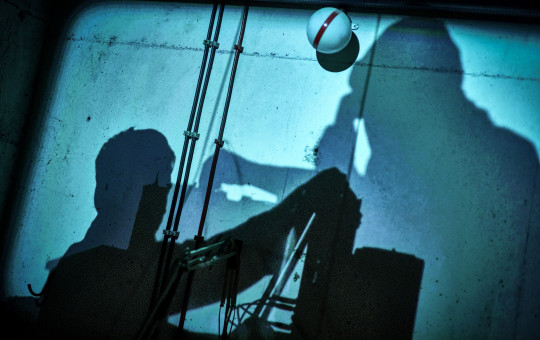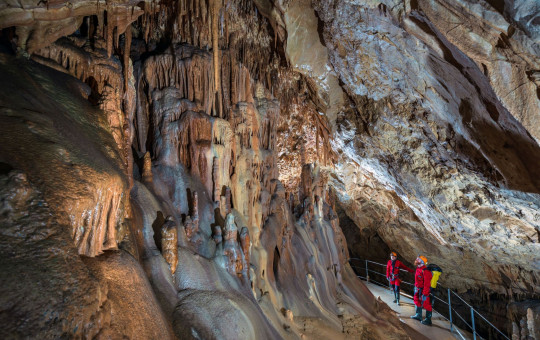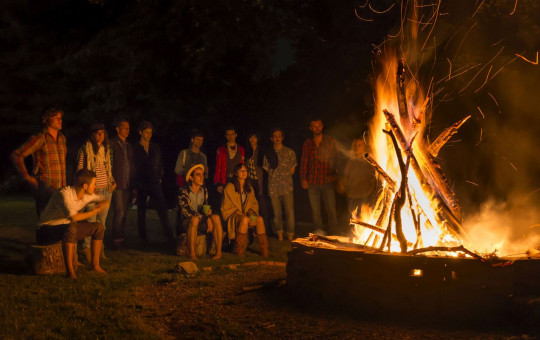Date: 14. December 2019
Time to read: 4 min
The streets of Ljubljana have many an interesting story to tell, and many of these stories began way back in time.
They have been around for centuries and have endured wars, occupations, earthquakes, long winters and changes in political regimes, only to be revived through cultural events, new buildings, tourist visits, planting arrangements and studies. Some of these stories are presented below.
Križevniška Street (Križevniška ulica)
The once dark and rather drab street in the old centre of Ljubljana has in the past ten years become one of the most beautiful and photographed in the city, thanks to director of Mini Theatre, Robert Waltl. Pictures of the street circulate around the internet and can be found in various tourist publications, but its inner beauty, reflected in the social ties among its residents, is even greater than its appearance suggests. In the afternoons and evenings the street’s residents gather spontaneously, with everyone bringing something to eat or drink.
And once a year (on 26 June) they organise a fun event called Križevniški sosed ("A neighbour from Križevniška Street"), which is supported by Ljubljana Tourism as one the best tourist events in the city, and to which all Ljubljana residents and guests are invited.
Križevniška Street was once home to fishermen, who fished the Ljubljanica and dried their nets on the street. Many notable figures also lived, worked or pursued their creative endeavours here, including the family of Blaž Crobath, father of poet Luiza Pesjakova and friend and patron of France Prešeren, who used to come here to visit his friend. Indeed this is where Prešeren met his wife, Ana Jelovškova, with whom he had three children.
A walk along the Cankar trail
The Slovenian writer, poet and playwright Ivan Cankar (1876–1918) lived in many different places in Ljubljana.
Why not go on a guided literary tour and learn about some of these, walk past the buildings where Cankar lived and worked, and listen to stories and anecdotes from his life and the lives of other important residents of Ljubljana at that time?
The trail takes us from Krek Square (Krekov trg) to the Poljane Embankment (Poljanski nasip), Streliška Street (Streliška ulica), Vodnik Square (Vodnikov trg), through Old Square (Stari trg) and Breg all the way to Congress Square (Kongresni trg), where Ivan Cankar spent his last days. The trail ends in front of the National Gallery on Cankar Street (Cankarjeva cesta), where on 11 December 1918 mourners paid their last respects to the great Slovenian writer.
The Ljubljana of Valentin Vodnik
A walk around Ljubljana in the time of Valentin Vodnik will take you to the buildings where the Slovenian poet (1758–1819) lived, created, was educated and gained the experiences that changed his life. It takes us along the streets of the city, in the footsteps of the poet, revealing many interesting stories about Ljubljana from the days when Vodnik lived and worked here, along with tales of his life and contemporaries.
Ljubljana for poetry lovers
Take a guided tour to visit Ljubljana’s well-known squares (Prešeren Square, Vodnik Square, Town Square, Old Square, Congress Square and Square of the Republic (Trg republike), along with some other locations around the city, where the tour guide will present a poet related to each place. Those on the tour will learn about France Prešeren, Kajetan Kovič, Svetlana Makarovič, Valentin Vodnik, Ciril Zlober, Lili Novy, Srečko Kosovel, Ivan Cankar, Oton Župančič, Ivan Minatti and Tomaž Šalamun, as well as their poems, recited by the tour guide, or even the participants themselves if they wish.
The oldest linden tree is almost 400 years old
The green lungs of Ljubljana conceal many stories of their own. Many of the trees have survived for centuries, surviving wars, droughts, and harsh winters. Although they cannot speak, there are many interesting facts about them which bring their stories to life. There are more than 180 species of tree in the capital. They contribute to the beauty of the city, which prides itself on having won the title of European Green Capital, but beyond their appearance the presence of trees is vital for life in the city. A mature tree absorbs 2.3 kg of carbon dioxide per hour and produces 1.7 kg of oxygen, which is enough for ten people to breathe.
Data in the digital register of city trees kept by Snaga shows that the tree with the largest circumference is the London plane on the lawn in front of Cankarjev Dom, with a circumference of 638 centimetres.
But this is only one of the many prominent trees to be admired in the city centre. A number of the trees are several hundred years old, having released over six tons of oxygen into the air during each century of their growth.
Povšetova Street (Povšetova ulica) – Known only for its prison
The association between Povšetova Street and the prison is so deeply rooted in the minds of Ljubljana residents that when somebody uses a phrase like "I’m going to Povšetova Street" or "he’s in Povšetova Street", this actually implies that somebody is in or is going to prison. But Povšetova Street is in fact a very pleasant street. The residential part, which runs through the district of Kodeljevo, is lined mostly with apartment buildings and family houses surrounded by gardens built before the Second World War.
And it is a very green street in more ways than one, the second being the reuse centre (Center ponovne uporabe), one of the most popular Slovenian recycling points, located at the very beginning of Povšetova Street in the part within the area of the city centre.
With the prison getting all the attention, Fran Povše, after whom the street was named, has been somewhat overlooked. The decision to name the street, previously called Ulica Kodeljevo and before that Cesta na Kodeljevo, after the agricultural expert and politician Fran Povše, who was interested in all types of agriculture, including silkworm breeding, and played a very important role in the development of fruit-growing in the Goriška region, was made back in 1937. Thanks to Fran Povše, cherries and peaches from the Goriška region were sold as far afield as Vienna.
Mašera–Spasić Street (Mašera Spasićeva ulica)
Mašera–Spasić Street was named after two national naval heroes, Mašera and Spasić, in 1974. Slovenia does not have many naval heroes, but the first name on the street, Sergej Mašera, is remembered in the history of all Yugoslav nations for his heroic deed performed together with his colleague and schoolmate from the Yugoslav Naval Academy, the second name on the street, Milan Spasić. Together they served on board the destroyer Zagreb, owned by the Royal Yugoslav Navy. When the country surrendered in 1941, their ship was docked in the Bay of Kotor and they were ordered by their superiors to turn it over to the Italians. But the crew decided to sink the ship instead. Some of the accounts of the developments on 17 April make dramatic reading indeed. It was a rainy and foggy day in the Bay of Kotor, and Mašera and Spasić refused to hand over the ship, as did the rest of the crew. They placed explosives in two carefully chosen areas below the deck. After the rest of the crew had left, they went inside the ship and lit the fuse. They then stood at the stern in full combat gear, tore off their insignia, hugged each other and looked towards Mt Lovćen… and then the explosion ripped the ship apart. The remaining crew and others on the shore saw their bodies being thrown high up in the air, and then the ship sank. Mašera and Spasić were aged 29 and 31, respectively. Subsequently there were certain interpretations according to which the sinking of the ship was the result of an accident rather than an intentional detonation. Despite this, they were officially recognised as war heroes in 1973, and a number of streets in the former state were named after them.
Zvezdarska Street (Zvezdarska ulica)
Some of the streets of Ljubljana are so short and so atypical of a city street that they could be hardly recognised as such. One of these is Zvezdarska Street, which runs from Levstik Square (Levstikov trg) or Karlovška Street (Karlovška ulica) to Rožna Street (Rožna ulica). A walk down the street brings you to the part of the city called Žabjak. The name of Žabjak originates from the 16th century, the reason being the marshy ground on which it was built. Žabjak later became a kind of autonomous zone, at least according to the local lads who competed with their peers from Prule to be recognised as “the biggest kid on the block”. The rivalry came at the end of the 1960s, when new settlers were moving into apartment blocks in Prule, while Žabjak residents were considered city-dwellers of longer standing.






